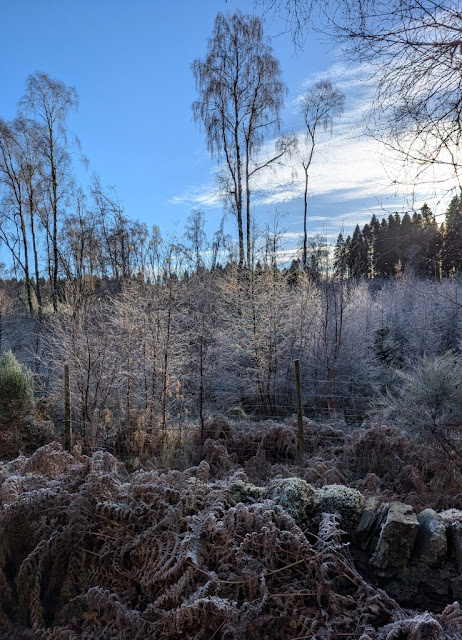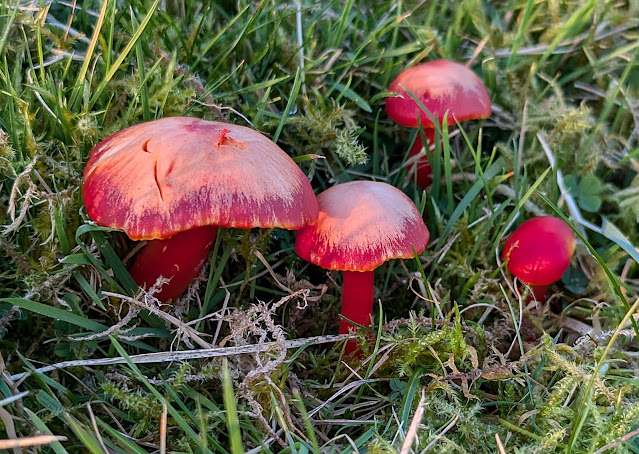It's been fridge-like weather-wise, days and nights of clear skies and sub-zero temperatures, then a big fall of snow, and now back to the cold again. I had to go to Gleneagles station in the snow, someone had a train booked for London. Little problem getting there, but getting home again was an adventure with other vehicles stuck and skidding all over the place. Thankful for the RAV4s capabilities, I navigated the chaos (and managed to help one or two others on the way).
 |
| Garden with snow, not inclined to sit outside with a coffee and cake. |
 |
| In the woods. |
The snow did produce Brambling for the garden, and only the second patch record.
Online, Birdtrack has been down for a few days and Naturespot went missing (temporarily), as did UK Beetles (and that might be permanent). One hopes a new and affordable host can be found for UK Beetles as it is a site full of invaluable information. Unfortunately, when I checked, the Wayback Machine had saved only a small fraction of the site.
I've been pulling stuff out of my specimen fridge/freezer to identify, the weather not being conducive to insect finding.
First off this Staphy I found on the garage wall a few weeks ago. It looks like a small Ocypus olens, so I went to the key for Ocypus/Tasgius and got horribly confused. In the end I decided a dissection was required, to be certain. I remembered I'd found that bit of the key confusing in the past. Without UK Beetles to check with I headed over to the excellent Danish site, which fortunately had images of the aedaegus as well. Useful as for once the illustrations in Lott are not entirely definitive to my eye.
 |
| Tasgius melanarius, the commonest one, but I'd not found it before. |
 |
| Good job it was a male, aedaegus image checked out against the Danish image. And when I posted it Harald S very quickly confirmed the ID (many thanks Harald). |
Next up were a couple of Carabidae from a river gravel sample from back in May, just after we got here. These should have been straightforward, but that was only half true. And then there was some fascinating biology.
The first one was easy, Paranchus albipes is so distinctive, and I can only think I took a sample just to prove it for a new locality (for me). However, it turned out that was a very good decision.
 |
| Paranchus albipes, but what's that on the corner of the pronotum? |
I usually ignore these fungi poking out of beetle elytra and elsewhere. However....
The other beetle turned out to be Ocys sp. A new genus for me. It keyed to Ocys harpaloides, but putting it into iRecord the species predictor suggested O. harpaloides agg. Mmmm, web search required, what's going on? The web search turned up an interesting issue, that until 2016 Ocys harpaloides was a straightforward identification, and then some researchers found we'd been getting it wrong and perhaps they were not O. harpaloides at all but a similar species Ocys tachysoides. Indeed, most identified since that publication have turned out to be the "new" species O. tachysoides and O. harpaloides is actually rather hard to find. I then remembered I'd stumbled across this before in my web meanderings on Beetles FB Group. Dissection required, see below. Most interesting and back to the Paranchus and its wee parasitic growth was a paper that popped out of the web search showing that these tiny fungal parasites of beetles are identifiable by identifying the beetle species. Each beetle species has been shown to generally only host one species of fungi, although the fungi may parasitise more than one beetle species. Only two beetle species have been found (so far) to host more than one species of fungi so identify your beetle and if the fungi is present there is a bonus species lurking there!
 |
| In the case of Paranchus albipes it is host to Laboulbenia flagellata. |
Both Ocys species host the same fungus, Laboulbenia vulgaris, which was present on my specimen.
And as expected my Ocys specimen turned out to be the "new" species Ocys tachysoides, which should probably only be identified to species by dissection.
 |
| Female genitalia, Ocys tachysoides. |
 |
| In particular the shape of the spermatheca is distinctive. |
 |
| And here are the parasitic growths of Laboulbenia vulgaris, not the best image in the world.... |
One more little episode to be added, perhaps in the next post..
Next out of the fridge was this beetle which I struggled with because the first tarsal segments are tiny, so I counted 4-4-4 when they were 5-5-5. After messing about in the Nitidulidae keys and failing to get anywhere I used Obsidentify which identified the beetle correctly immediately. I then worked it through the correct Dermestidae key and came out at the same answer, Attagenus pellio, Two-spotted Carpet Beetle.
 |
| Two-spotted is a bit of a misnomer as it has at least five spots, if not seven and three are quite obvious. |
The species has no certain records for Scotland on the NBN, is an adventive, but is generally found outside on flowers. I did find it inside the house but this was a period when the kitchen window ledge was collecting quite a few insects as we were having the back door open a lot of the time. ID confirmed by Max B, thanks Max. I suspect the NBN is out of date, but I'll try to find out more.




















